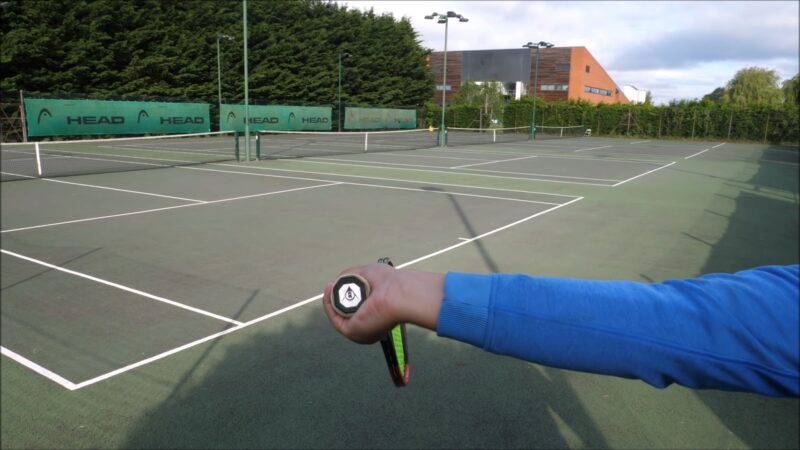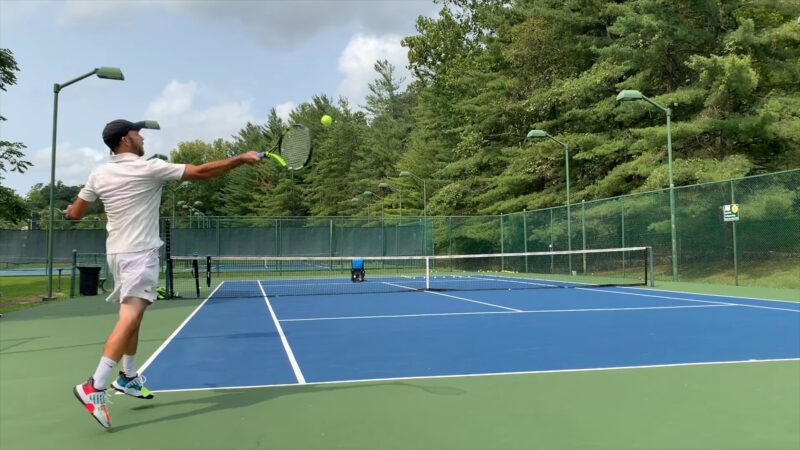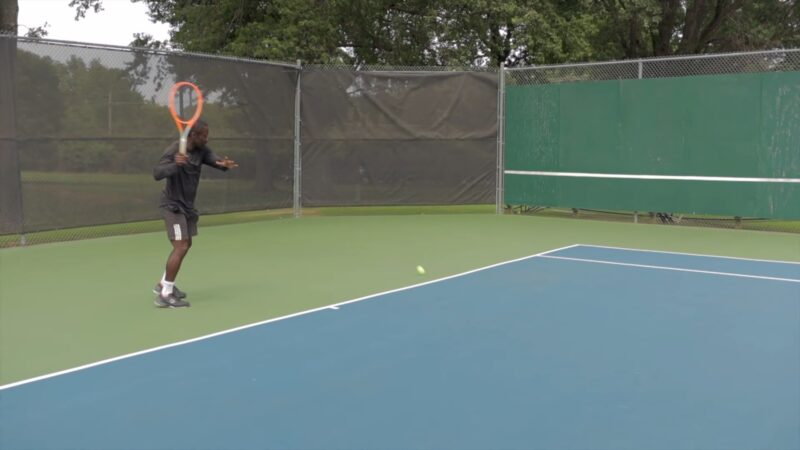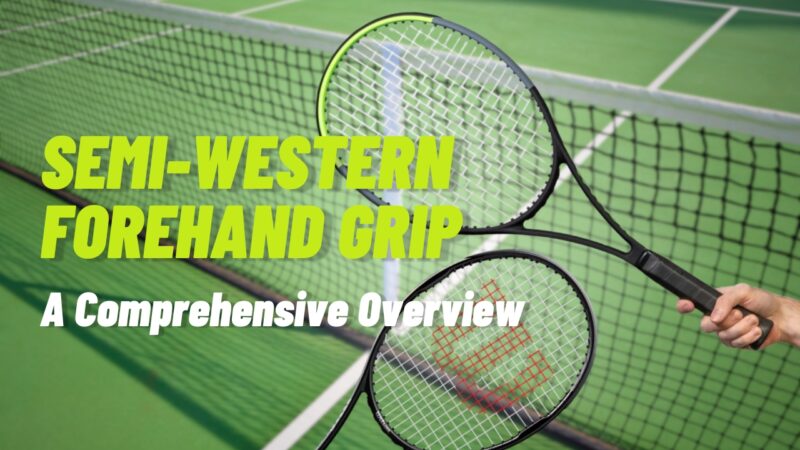Tennis, a game of strategy, finesse, and power, requires a thorough understanding of the fundamental techniques, with the grip being among the most vital. The Semi-Western forehand grip is one such technique that can truly elevate a player’s game. In this blog post, we’ll dive deep into the nuances of this gripping style, demystifying its origins and its myriad advantages.
This grip is a modern style favored by professional players for its balance of power and topspin. It offers a perfect blend of aggressive play and control, leading to its popularity in the current era of fast-paced, power-based tennis. It has become the gold standard in today’s professional circuits.
The Basics
Before we delve into the intricacies of the Semi-Western grip, it’s crucial to grasp the fundamental concept of tennis grip. Imagine the handle of your racquet as the face of a clock: the top being 12 and the bottom being 6. Traditionally, with an Eastern grip, your base knuckle would be on the 3 (for a right-handed player) or 9 (for a left-handed player).
However, with the Semi-Western grip, you shift your base knuckle to 4 (for a right-handed player) or 8 (for a left-handed player). It’s this simple shift that generates the magic of the Semi-Western grip. The bevels, the 8 flat sections on the racquet’s handle, become your guide here, specifically, Bevel 4 for right-handers and Bevel 8 for left-handers.
History of the Semi-Western Grip
The Semi-Western grip became prevalent around the 1970s, a transition from the traditionally used Eastern grip. The game’s evolution towards a faster, more aggressive play style demanded techniques that could deliver power without compromising control, which is whesre the Semi-Western grip found its niche.
This technique allowed players to generate powerful groundstrokes imbued with heavy topspin. Not only did this fundamentally change the dynamics of the game, but it also led to the rise of players who relied on baseline power play. It continues to be the favored grip of many tennis greats, including Rafael Nadal and Serena Williams.
Advantages of the Semi-Western Grip
There are numerous reasons why the Semi-Western grip has gained such widespread popularity, both among professional players and amateurs. Here’s why:
Topspin Generation
This grip naturally imparts more topspin on the ball, making the shot safer as the ball is more likely to dip back into the court. This is beneficial in today’s game, where hitting with depth and power is crucial.
Power and Control

The Semi-Western grip offers a balance between power and control that is hard to find in other variations. Players can deliver aggressive shots while maintaining precision and consistency.
How to Master It
Mastering the Semi-Western grip can take some time, especially if you’re transitioning from a different grip style. However, with consistent practice and focus on the right technique, it’s a skill that can be acquired. Start by positioning your hand correctly on the racquet handle, as outlined earlier. From there, work on the transition from your grip to the contact point and follow through.
Use a progression-based approach to learning. Begin with slow, controlled swings focusing on maintaining the grip through the entire stroke. As you grow comfortable, start increasing the pace of your swings, aiming for depth and topspin. A key aspect of mastering this grip is maintaining the ‘windshield wiper’ motion, wherein your racquet’s head moves in an upward and circular motion post-contact, generating topspin.
Playing Against High-Bouncing Balls

The Semi-Western grip shines when playing against high-bouncing balls. Unlike the Eastern or Continental grip, the Semi-Western allows you to make contact at a higher point, making it easier to return deep, high-bouncing shots. In fact, with the right timing and swing path, you can convert these defensive situations into offensive opportunities.
Remember, your swing path will be low-to-high, brushing up the back of the ball to generate topspin. This, in combination with the natural inclination of the Semi-Western grip to handle high balls, makes it a potent tool in your tennis arsenal.
Considerations for the Transition Game
The transition game, moving from the baseline toward the net, can be a bit more challenging with the Semi-Western grip. It’s not as naturally suited for flat or slice shots, often used during approach shots, as the Eastern or Continental grip. However, with practice, you can certainly improve this aspect of your game with the Semi-Western grip.
A strategy here can be to hit a heavy topspin approach shot that lands deep in your opponent’s court, forcing a defensive return. This can give you the time to reach the net and prepare for a volley or an overhead smash.
The Semi-Western Grip in Professional Tennis
In professional tennis, the Semi-Western grip is the dominant choice. Powerhouse players like Rafael Nadal and Serena Williams employ it to unleash their devastating groundstrokes. Nadal, with his lethal topspin forehand, and Williams, with her powerful baseline play, showcase the potential of the Semi-Western grip at the highest level.
These players’ success attests to the effectiveness of the Semi-Western grip in today’s fast-paced, power-oriented game. It allows them to deliver crushing blows from the baseline, all the while maintaining control and consistency in their shots.
Drawbacks of the Semi-Western Grip
While the Semi-Western grip offers a range of advantages, it does come with its share of drawbacks. It’s not as naturally suited for low balls as the Eastern or Continental grip. This means that players using the Semi-Western grip might struggle against opponents who hit low, flat shots.
Additionally, the grip requires more physical effort compared to others, which could lead to fatigue in long matches. However, these drawbacks can be managed with a comprehensive fitness routine and tactical gameplay.
Adapting to Different Court Surfaces
One of the remarkable attributes of the Semi-Western grip is its adaptability to various court surfaces. Its ability to generate topspin can be advantageous on clay courts, where balls tend to bounce higher. On the other hand, even on fast hard courts, the grip allows for aggressive baseline play, making it versatile across different conditions.
However, on grass courts, where the ball often stays low, players might need to adapt their stance and swing path to handle low balls effectively. It’s crucial to be aware of these differences and make the necessary adjustments.
Ideal Racquets for the Semi-Western Grip
The racquet you use can also impact your performance with the Semi-Western grip. A racquet with a larger head size can offer more power and spin potential, making it a suitable choice for this grip style.
Racquets with a higher swing weight can also help generate more power and depth in your shots. However, it’s important to choose a racquet that matches your physical capabilities to avoid potential injuries. Brands like Babolat, Wilson, and Head offer a variety of racquets that can complement the Semi-Western grip.
Training Drills
Practice is key to mastering the Semi-Western grip. Here are some drills to help you get started:
Wall Practice

This is a simple but effective drill. Stand about 6 feet away from a wall and hit forehands using the Semi-Western grip. This helps in getting a feel of the grip and the contact point.
Basket Drill
Place a basket in the service box of your opponent’s side. Try to hit forehand shots with your Semi-Western grip aiming to land the ball in the basket. This will help improve your control and precision.
The Role of Physical Fitness
Using the Semi-Western grip effectively requires a good level of physical fitness. It’s physically demanding, requiring strong wrists, forearms, and core muscles. Incorporating strength and conditioning exercises into your training routine can significantly enhance your ability to wield this grip efficiently.
A strong core can help maintain balance and stability, while strong wrists and forearms can help generate power and spin. Regular fitness training is hence integral to mastering the Semi-Western grip.
Common Mistakes to Avoid
As you embark on your journey to master the Semi-Western grip, be wary of common mistakes. These include not maintaining the grip throughout the stroke, improper contact points, and not generating enough topspin. Another common mistake is not adjusting the swing path for different ball heights.
Remember, the key to mastering the Semi-Western grip is consistent practice and focusing on the correct technique. With patience and persistence, you’ll find your forehand transformed, becoming a reliable and potent weapon in your game.
Closing Thoughts
The Semi-Western forehand grip is a dynamic tool that can significantly enhance your tennis game. While it does require practice and physical effort, the payoff in terms of power, control, and adaptability makes it worth the investment. Whether you’re an amateur or aspiring to go professional, understanding and mastering this grip can be a game-changer.
A good and sturdy grip style provides precise tennis serves, allowing you to score more and increase your chances of winning your matches.
Never stop practicing and fine-tuning your grip as it’s one of the key elements that can take your game to a whole new level. Embrace the journey and enjoy the game. As tennis legend Billie Jean King once said, “Tennis is a perfect combination of violent action taking place in an atmosphere of total tranquility.”

